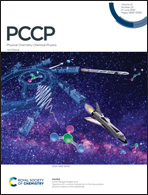The transformation of cuboctahedral to icosahedral nanoparticles: atomic structure and dynamics†
Abstract
The rearrangement of transition metal nanoparticles from cuboctahedral to icosahedral structures is studied for up to 923 atoms. The atomic structure and temperature dependence of the transition are investigated with a well-defined collective variable. This collective variable describes the folding of the square fcc(100) facets into two triangular facets through a linear combination of the diagonals of all fcc(100) facets of all shells of the particle. Activation barriers are determined through harmonic transition state theory and constrained molecular dynamics simulations based on force field potentials. These calculations predict an activation entropy larger than 1 meV K−1, leading to strongly temperature dependent activation barriers. Density functional theory calculations were additionally performed both as single point calculations and as full optimizations. Cu, Ag, Au and Ni clusters show low barriers for concerted, symmetric transition up to the 309-atomic clusters. In contrast, for Pd, Pt, Rh and Ir higher barriers are required, already for the 147-atomic clusters. With increasing barriers, an asymmetric but still concerted rearrangement becomes energetically more favorable than the fully symmetric transformation. The material-dependence of the transition can be correlated with the melting point of the bulk metals.

- This article is part of the themed collection: 2020 PCCP HOT Articles


 Please wait while we load your content...
Please wait while we load your content...